Deciding between in-house vs. outsourced bag manufacturing? In-house offers superior quality control, while outsourcing provides scalability and lower startup costs.

What Are the Core Manufacturing Models for Bags?
The Case for In-House Bag Production: Control and Craftsmanship
Key Challenges of Manufacturing In-House
The Appeal of Outsourcing Bag Manufacturing: Scale and Expertise
Potential Pitfalls of Outsourcing Production
How to Choose the Right Path for Your Bag Brand?
A Hybrid Approach: Can You Have the Best of Both Worlds?
Making the Final Decision: A Comparative Summary

What Are the Core Manufacturing Models for Bags?
The journey from a design sketch to a finished bag involves a critical decision: who will actually make it? This choice boils down to two primary models, each with distinct operational frameworks and strategic implications for a brand. Understanding the fundamental differences between bringing production under your own roof and partnering with an external facility is the first step toward building a sustainable and successful business.

Defining In-House Production
In-house production, also known as self-production or vertical integration, is the practice of a company manufacturing its own products within its own facilities. From sourcing raw materials like full-grain leather to the final stitch, every step of the creation process is managed directly by the brand. This model requires a dedicated space, specialized machinery, and a skilled team of artisans, cutters, and quality assurance personnel.
Understanding Outsourced Manufacturing
Outsourcing involves contracting a third-party factory or production house to manufacture products on your behalf. This is often called contract manufacturing. The external partner handles the physical production based on your designs, specifications, and material requirements. These partners can be domestic (onshoring) or international (offshoring), and they typically work with multiple brands, leveraging their established infrastructure and workforce to produce goods at scale.
The Case for In-House Bag Production: Control and Craftsmanship
For brands where the product is the hero, keeping manufacturing in-house provides an unparalleled level of command over the final output. It is a commitment to quality that goes beyond simple inspection, embedding the brand’s ethos into the very fabric of the product.
Unmatched Quality Control
With an in-house team, you have direct oversight of the entire production line. You can meticulously monitor every detail, from the hide selection and cutting precision to the stitching tension and hardware attachment. If a flaw is detected, it can be corrected instantly, preventing waste and ensuring that every single item meets your exacting standards. This hands-on approach is what allows for the creation of truly premium goods where consistency is paramount.
Protecting Your Intellectual Property
Your designs, patterns, and innovative construction techniques are valuable assets. When you manufacture in-house, your intellectual property (IP) stays within your walls. This significantly reduces the risk of your unique designs being replicated or shared with competitors, a common concern when working with third-party factories that may also produce for other brands.
Fostering Brand Identity and Storytelling
A powerful brand story is built on authenticity. Manufacturing your own products allows you to tell a compelling narrative about craftsmanship, materials, and the people behind the product. For brands like Beldtura, where every full-grain leather bag tells a story of artisanal skill, keeping production in-house is non-negotiable. It is the only way to ensure each stitch reflects our commitment to timeless quality and durability. This direct connection to the creation process resonates deeply with customers who value transparency and artistry.
Agility and Prototyping Speed
Having your production team just steps away from your design team creates a dynamic feedback loop. New ideas can be prototyped, tested, and refined in days rather than weeks or months. This agility allows a brand to be more responsive to market trends, experiment with new materials, and perfect a design without the lengthy communication and shipping delays associated with external partners.
Key Challenges of Manufacturing In-House
While the benefits are significant, the path of in-house production is paved with substantial operational and financial hurdles. It is a resource-intensive model that is not suitable for every business, particularly those just starting out.
Significant Initial Investment
The primary barrier to in-house production is the high capital expenditure. This includes the cost of leasing or purchasing a facility, investing in industrial sewing machines, cutting tables, and other specialized equipment, and stocking an inventory of raw materials. These upfront costs can be prohibitive for new brands or small businesses.
The Burden of Operational Management
Running a manufacturing facility is a full-time job. It involves managing a skilled workforce, maintaining equipment, ensuring workplace safety compliance, and overseeing the entire supply chain. These responsibilities demand a different skill set than designing and marketing, adding a thick layer of complexity to business operations.
Scalability Hurdles
Scaling up production in-house is a slow and expensive process. To increase output, you need to invest in more space, more machines, and more skilled labor. This can make it difficult to respond to sudden surges in demand or to grow the business rapidly without significant additional investment.
The Appeal of Outsourcing Bag Manufacturing: Scale and Expertise
Partnering with a third-party manufacturer is an attractive and often necessary strategy for brands focused on growth, market reach, and operational efficiency. It allows a company to leverage external resources to achieve goals that would be unattainable on their own.
Reduced Capital Expenditure
The most compelling advantage of outsourcing is the dramatically lower initial investment. You do not need to buy expensive machinery or rent a large workshop. Instead, you tap into the existing infrastructure of your manufacturing partner. This frees up capital that can be invested in design, marketing, and brand building—the activities that drive sales.
Access to Specialized Skills and Technology
Established factories often possess decades of experience and highly specialized equipment that would be too costly for a single brand to acquire. Whether it is intricate leather embossing, advanced waterproofing techniques, or high-volume precision cutting, outsourcing can provide access to a level of technical expertise and technology that elevates the quality and capabilities of your product line.
Streamlined Scalability
Outsourcing makes scaling production remarkably straightforward. If demand for your bags doubles, you simply increase the size of your order with the factory. Reputable manufacturers have the capacity and workforce to handle fluctuating Minimum Order Quantities (MOQs), allowing your brand to grow without the pains of expanding its own physical infrastructure.
Potential Pitfalls of Outsourcing Production
While outsourcing offers a path to rapid growth, it also introduces risks and relinquishes a degree of control that can impact a brand’s reputation and bottom line. Navigating this path requires careful partner selection and robust management systems.
Risks to Quality and Consistency
When production is happening hundreds or thousands of miles away, maintaining consistent quality is a major challenge. Without direct oversight, there is a risk of corners being cut, materials being substituted, or workmanship standards slipping. A single bad batch can damage customer trust and lead to costly returns.
Communication Barriers and Lead Times
Working with external partners, especially overseas, can introduce communication challenges due to differences in language, time zones, and business culture. This can slow down decision-making and problem-solving. Furthermore, international shipping and customs clearance add significant time to your production calendar, resulting in longer lead times and less flexibility.
Less Control Over the Supply Chain
Outsourcing means you have less visibility into your supply chain. This can be a concern for brands committed to ethical and sustainable sourcing. It becomes more difficult to verify the origin of materials or ensure that labor practices meet your brand’s ethical standards, posing a potential risk to your brand’s reputation.
How to Choose the Right Path for Your Bag Brand?
The correct manufacturing strategy is not one-size-fits-all. It depends entirely on your brand’s unique circumstances, values, and long-term vision. Asking the right questions is key to making an informed choice.
Assessing Your Business Stage and Goals
Are you a startup aiming for rapid growth and market penetration, or an established artisan brand focused on a niche market? A startup may lean toward outsourcing to conserve capital and scale quickly. A brand built on the promise of unparalleled craftsmanship may find in-house production to be the only option that aligns with its core values.
Evaluating Your Financial Resources
A realistic assessment of your budget is critical. Do you have the significant capital required to set up a workshop and hire a team? Or does your financial model depend on a lower upfront investment and a variable per-unit production cost? Your balance sheet will heavily influence this decision.
Considering Your Product’s Complexity and Niche
How complex and unique are your bag designs? Simple, high-volume products like canvas totes may be well-suited for outsourcing. However, intricate leather bags with proprietary hardware and complex construction techniques often benefit from the close supervision and iterative development process that only in-house production can provide.
A Hybrid Approach: Can You Have the Best of Both Worlds?
It is important to recognize that the choice between in-house and outsourcing is not always a binary one. Many successful brands employ a hybrid model. This could involve keeping the design, prototyping, and production of flagship or limited-edition items in-house to maintain a core of artisanal quality. Simultaneously, they might outsource more basic, high-volume product lines to a trusted partner to achieve scale and market reach. This balanced strategy can offer an effective compromise, leveraging the strengths of both manufacturing models.
Making the Final Decision: A Comparative Summary
Ultimately, the choice shapes the foundation of your business. One path prioritizes absolute control and brand story, while the other prioritizes financial flexibility and scale. Weighing these factors against your specific goals will illuminate the best way forward for your brand.
| Factor | In-House Production | Outsourcing |
|---|---|---|
| Quality Control | Maximum control, instant feedback | Requires rigorous vetting and monitoring |
| Upfront Cost | Very High (equipment, facility) | Very Low |
| Scalability | Slow and expensive | Fast and efficient |
| IP Protection | High security | Potential risk, requires NDAs |
| Speed to Market | Faster prototyping, slower mass production | Slower prototyping, faster mass production |
| Brand Story | Strong “Made by Us” narrative | Focuses on design and brand vision |

